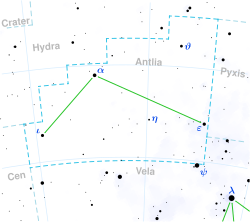Alfa Antliae
Utseende
| Alfa Antliae | |
 | |
| Observationsdata Epok: J2000.0 | |
|---|---|
| Stjärnbild | Luftpumpen |
| Rektascension | 10t 27m 09,10313s[1] |
| Deklination | -31° 04′ 03,98″[2] |
| Skenbar magnitud () | 5,22-5,29 (V)[3] |
| Stjärntyp | |
| Spektraltyp | K3III[2] |
| U–B | 1,63[4] |
| B–V | 1,429±0,048[5] |
| R–I | 0,79[4] |
| Variabeltyp | Misstänkt variabel stjärna[3] |
| Astrometri | |
| Radialhastighet () | 12,2 ± 2[6] km/s |
| Egenrörelse (µ) | RA: -83,335 ± 0,492[1] mas/år Dek.: 8,269 ± 0,475[1] mas/år |
| Parallax () | 10,0734 ± 0,3348[1] |
| Avstånd | 320 ± 10 lå (99 ± 3 pc) |
| Absolut magnitud () | -0,97[7] |
| Detaljer | |
| Massa | 2,2[8] M☉ |
| Radie | 41[1] R☉ |
| Luminositet | 412[1] L☉ |
| Temperatur | 4 070[1] K |
| Metallicitet | -0,39[9] |
| Andra beteckningar | |
| GSC 07184-02065, 2MASS J10270911-3104039, SKY# 20072, CD-30 8465, HD 90610, N30 2482, SRS 30392, CPC 17 5084, HIC 51172, NSV 4862, TYC 7184-2065-1, CPD-30 3121, HIP 51172, PLX 2452, UBV 9659, FK5 392, HR 4104, PLX 2452.00, UBV M 16238, GC 14352, IRAS 10248-3048, PMC 90-93 283, WEB 9355, GCRV 6563, IRC -30164, PPM 287713, YZ 120 6900, GEN# +1.00090610, JP11 1951, SAO 201405, Gaia DR2 5449188358926934016[2] | |
Alfa Antliae är den ljusstarkaste stjärnan i stjärnbilden Luftpumpen. Alfa Antliae har en visuell magnitud som varierar mellan +4,22 och 4,29. Ljusvariationerna rapporterades först av den amerikanske astronomen Benjamin Gould 1879, men har inte bekräftats i modern tid. Stjärnan ligger på ungefär 320 ljusårs avstånd.
Referenser
[redigera | redigera wikitext]- Den här artikeln är helt eller delvis baserad på material från engelskspråkiga Wikipedia, tidigare version.
Noter
[redigera | redigera wikitext]- ^ [a b c d e f g] Brown, A. G. A.; et al. (Gaia collaboration) (August 2018). "Gaia Data Release 2: Summary of the contents and survey properties". Astronomy & Astrophysics. 616. A1. arXiv:1804.09365. Bibcode:2018A&A...616A...1G. doi:10.1051/0004-6361/201833051. Gaia DR2 record for this source at VizieR.
- ^ [a b c] ”Basic data: V* alf Ant – High proper-motion Star” (på engelska). Centre de Données astronomiques de Strasbourg. http://simbad.u-strasbg.fr/simbad/sim-basic?Ident=alf+Ant&submit=SIMBAD+search. Läst 2 mars 2019.
- ^ [a b] 43486 ”NSV 4862” (på engelska). The International Variable Star Index. AAVSO – American Association of Variable Star Observers. https://www.aavso.org/vsx/index.php?view=detail.top&oid= 43486. Läst 2 mars 2019.
- ^ [a b] Hoffleit, D.; Warren, Jr., W. H. "HR 4104". The Bright Star Catalogue (5th revised ed.). Centre de Données astronomiques de Strasbourg. Hämtad 2008-10-03.
- ^ van Leeuwen (2007). ”Hipparcos, the New Reduction” (på engelska). http://vizier.u-strasbg.fr/viz-bin/VizieR-5?-out.add=.&-source=I/311/hip2&HIP=51172. Läst 2 mars 2019.
- ^ Evans, D. S. (June 20–24, 1966). "The Revision of the General Catalogue of Radial Velocities". In Batten, Alan Henry; Heard, John Frederick. Determination of Radial Velocities and their Applications, Proceedings from IAU Symposium no. 30. University of Toronto: International Astronomical Union. Bibcode:1967IAUS...30...57E.
- ^ Cardini, D. (January 2005), "Mg II chromospheric radiative loss rates in cool active and quiet stars", Astronomy and Astrophysics, 430: 303–311, arXiv:astro-ph/0409683, Bibcode:2005A&A...430..303C, doi:10.1051/0004-6361:20041440.
- ^ Alpha Antliae, Stars, Jim Kaler. Upptagen on line 3 oktober 2008.
- ^ McWilliam, Andrew (December 1990). "High-resolution spectroscopic survey of 671 GK giants. I - Stellar atmosphere parameters and abundances". Astrophysical Journal Supplement Series. 74: 1075–1128. Bibcode:1990ApJS...74.1075M. doi:10.1086/191527.
| ||||||||||||||||





